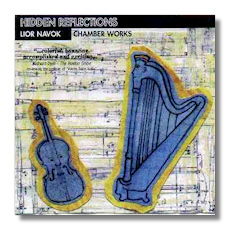
The Internet's Premier Classical Music Source
Related Links
- Latest Reviews
- More Reviews
-
By Composer
-
Collections
DVD & Blu-ray
Books
Concert Reviews
Articles/Interviews
Software
Audio
Search Amazon
Recommended Links
Site News
 CD Review
CD Review
Lior Navok

Hidden Reflections
Chamber Works
- Hidden Reflections - for Alto Saxophone, and Piano (1996)
- Quartet for Flute, Clarinet, Bassoon, and Harp (1994)
- "Voices from India" (String Quartet #1) (1997)
Styliani Tartsinis, alto saxophone
Jenny Tang, piano
Ruty Itzcovitch-Eyal, flute and piccolo
El'ad Avakrat, clarinet
Eyal Streett, bassoon
Gittit Alpert, harp
Christina Day and Anna Bard, violins
Eric Paetkau, viola
Erica Wise, 'cello
Recorded in Boston, Massachusetts, December 1997 (Hidden Reflections)
Jaffa, Israel, January 1998 (Quartet) and
Cambridge, Massachusetts, May 1998 ("Voices from India")
Produced by Lior Navok
NLP 22692 Total time 58:43 (distributed by Jem Music)
The music of our time is often self-consciously up-to-date. Some composers seem to follow an iconoclastic modernism, seeking primarily to overthrow the traditional at any cost. Then there is another, more respectful attitude, as exemplified here, which works to combine and integrate a wide variety of styles and influences in order to preserve continuity with as much of the fabric of the past as possible.
This set of works covers a lot of ground and successfully pulls together its many influences. Navok claims Ravel, Bartók, Messiaen, and Bill Evans; and I hear Satie and possbily even Victor Herbert as well. The composer has obviously done a lot of listening across a broad range of styles and learned many things from that endeavor.
For example, the second movement of the title piece recalls the style of Messiaen, and the Quartet for winds and harp owes a lot to the spare, genial style of the Velvet Gentleman, Satie. This Quartet is charming and well-constructed, tonal and with a consistent mood. Like the music of Satie, behind an apparently simple, pleasant, and accessible surface is a complex structure and organisation. Clearly, much thought has gone into this composition.
The other sources for this music stretch much further than France, but not always where the liner notes suggest. For example, I heard only a little of the Indian Classical forms of Alap and Raga in the string quartet. Although I'm sure they are there in the structure of the piece, they do not surface.
In the end I am left wondering how to characterize Navok's own style. I don't want to leave the impression that his music is a mere kaleidescope of effects and quotations when in fact it holds together very well. It is just that these pieces are all so very different from each other and employ such a wide variety of techniques that I find it impossible to give a single description that applies to the set as a whole. Perhaps in time the outlines that contain these works will become clearer.
"Something for everyone" would be the motto of this composer.
Copyright © 1999, Paul Geffen














